#the great molasses flood of 1919
Text
No matter which one wins, everybody loses!
#I got polls this is how I am celebrating#disasters#the great fire of rome#mount vesuvius#pompeii#the black death#the plague#the donner party#cannabalism#earthquake#fire#titanic#the great molasses flood of 1919#boston molasses flood#hindenburg#the great smog#chernobyl
2K notes
·
View notes
Text
Thinking about the time I wanted to show my friend my favorite episode of puppet history after talking about it for months with her and trying to get her to watch it and I showed her the Great Molasses Flood and was laughing through the whole thing cause I love that episode and at the end she said "it would've been better if I was drunk" and I went. ok. And then she proceeded to make me watch like 5 of those old rap battles between either historical figures or fictional characters and she kept saying, isn't this so funny, these are so smart and great, they don't make videos like this anymore, and I had to sit there and say wow, and yeah, and that's pretty funny, as if she didn't just shit on my favorite episode from one of my favorite pieces of art, and then force me to watch rap battles with characters from movies I've never seen
#fr i was so bummed and disappointed#we watched so many rap battles#youtube#puppet history#the great molasses flood#the great molasses flood of 1919#shane madej#and i told her about shane madej and i was like. hes great. i think hes super talented#and she went. buzzfeed guy kinda lame#this is also the same person that turned my music down in the car and then blares her music and yells over it so she can still hear it#rap battles#youtube rap battles#she was like. you gotta watch the rest of them and i said maybe. i will not be watching them#why is it ok for people to shit on my interests and then expect praise for their shitty interests?#watcher#watcher entertainment
27 notes
·
View notes
Text
happy death day molasses horse!

19 notes
·
View notes
Text
Happy Great Boston Molasses Flood of 1919 day, everyone. Celebrate by flooding your street with 8,700 metres cubed of molasses.
78 notes
·
View notes
Text
Happy anniversary to the Great Boston Molasses flood of 1919! Thinking of you!
#molasses#the great molasses flood#the great Boston molasses flood of 1919#it’s been 105 years#hands down my favorite event in American history#I have a book about it#dark tide by Stephen Puleo#it’s fascinating#and very telling#I say stuff and things#text post
10 notes
·
View notes
Text

based off a tumblr post that i saw a while ago. i wish i saved it
#noriaki kakyoin#jotaro kujo#jjba#jojo's bizarre adventure#kaye art#kakyoin looks cute here but like#he was probably just talking about the great molasses flood that took place in 1919 and killed 21 people#and was explaining the process of the exactly how people got stuck in it and suffocated to death#jotaro afterwards is like wow. imagine polnareff falling into that
60 notes
·
View notes
Text
I like to imagine that Sweet Bod by Lemon Demon is directly related to the Great Molasses Flood of 1919
#lemon demon spirit phone#lemon demon#sweet bod#spirit phone#neil cicierega#great molasses flood of 1919#i hope you understand
5 notes
·
View notes
Text
Happy January 15th, 2024, 105th anniversary of Boston's Great Molasses Flood of 1919. 21 people drowned and about 105 were injured in a massive wave of molasses which burst from a giant holding tank. The tank broke open at about 12:30 PM on an unusually warm winter day and flooded the North End neighborhood of Boston, MA. Legends say that on warm winter days you can still smell molasses in the streets.
#history#boston#semi shitpost#I remembered about this today (the 11th)#Because I was holding brown sugar and I could smell the molasses in it#And I was like “hm didn't that happen in mid to late winter”#“hey google when was the great molasses flood”#“The Great Molasses Flood Began On January 15th 1919”#“oh that's sooner than I thought I thought it was in like march”#“kinda want to post about it”#“but will I remember???”#“press x”#therefore#scheduled post
1 note
·
View note
Text
youtube
105 years ago.
And yes, I did mark the centenary five years ago.
0 notes
Text
my horny ass would not have survived the great molasses flood of 1919 in boston, massachusetts
2K notes
·
View notes
Text
the more I learn about the great molasses flood of 1919, the more I realize poetry can only go so far and some catastrophic sugar substitute events will just outdo you every time.
48K notes
·
View notes
Text
Digging History Magazine Volume 2023: Issue 1 is Out!
I’m a bit late posting this, but the first issue of 2023 is out and begins the year with an extended (two-part) series on the “Roaring Twenties”. I originally planned to focus solely on the years 1920-1929, but after discovering how volatile the period of time between the end of World War I and the beginning of a new decade were, I decided to start out with an extensive look at 1919. I hope you…

View On WordPress
#anarchy#Calvin Coolidge#Carbon Petroleum Dubbs#election of 1920#Great Molasses Flood of 1919#Prohibition#race riots#Roaring Twenties#the decade that changed America#the Elaine Massacre#The Great Red Scare#The Red Summer of 1919#Warren Harding#Woodrow Wilson#World War I
0 notes
Text
Thought of this and I had to

Edit: Image ID via @whoopsie-daisies-sys
[Image ID] A photograph from the great molasses flood of 1919. In front of the photo is text that says "The Great Vanilla Extract Flood of 2023". [End ID]
12K notes
·
View notes
Photo
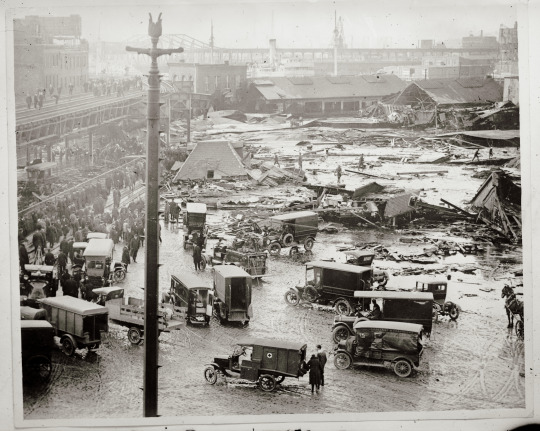
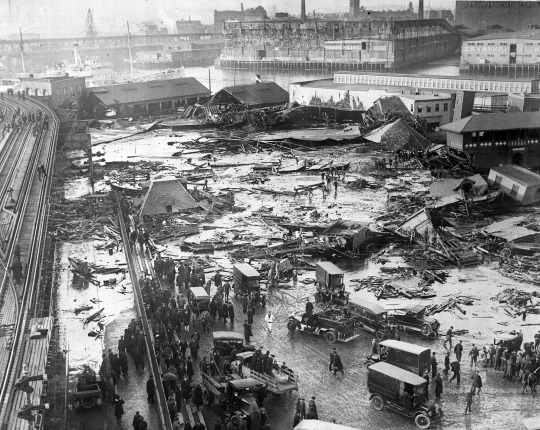



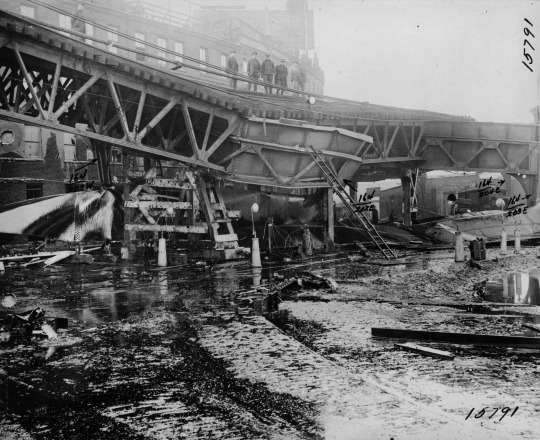
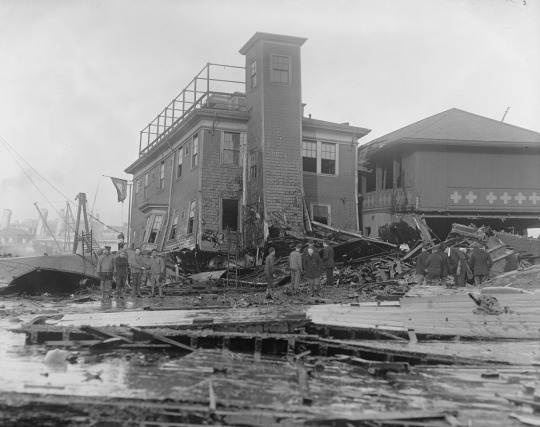

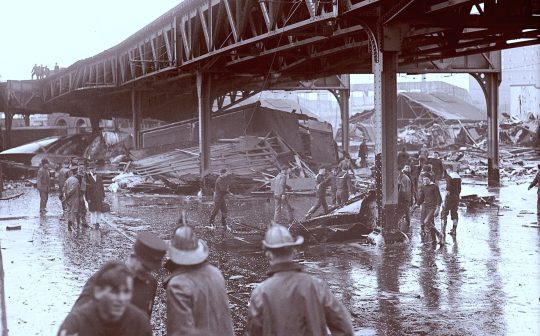
The Great Molasses Flood was a disaster in Boston that occurred after a storage tank collapsed on January 15, 1919, sending more than two million gallons (eight million litres) of molasses flowing through the city’s North End. The deluge caused extensive damage and killed 21 people.
The tank was built in 1915 along Boston’s waterfront on Commercial Street, opposite Copp’s Hill. It was operated by the Purity Distilling Company, a subsidiary of United States Industrial Alcohol (USIA). At the time, industrial alcohol—then made from fermented molasses—was highly profitable; it was used to make munitions and other weaponry for World War I (1914–18). The tank’s immense size reflected the demand: it measured more than 50 feet (15 metres) high and 90 feet (27 metres) in diameter and could hold up to 2.5 million gallons (9.5 million litres) of molasses. Built quickly, the tank was problematic from the start, leaking and often emitting rumbling noises. Nevertheless, it continued to be used, and after the war’s conclusion USIA focused on producing grain alcohol, which was in high demand as prohibition neared passage.
At approximately 12:30 PM on January 15, 1919, the tank burst, releasing a deluge of “sweet, sticky death.” According to reports, the resulting wave of molasses was 15 to 40 feet (5 to 12 metres) high and some 160 feet (49 metres) wide. Traveling at approximately 35 miles (56 km) per hour, it destroyed several city blocks, leveling buildings and damaging automobiles. Although help arrived quickly, the hardening molasses made rescue efforts difficult. In the end, 21 people were killed, many of whom were suffocated by the syrup, and approximately 150 were injured. In addition, the Boston Post noted that a number of horses had “died like so many flies on sticky fly paper.” Clean-up efforts lasted for weeks, and Boston reportedly continued to smell like molasses for years afterward.
Numerous lawsuits were filed in the wake of the disaster. While victims alleged that the tank was not safe, USIA claimed that it had been sabotaged by “evilly disposed persons.” In 1925, however, it was ruled that the tank was unsound, and USIA was ordered to pay damages. In addition, the disaster resulted in stricter construction codes being adopted by states across the country.
For years, questions were raised over how such a seemingly benign substance could have caused so many deaths. In 2016, researchers released a study that placed the blame on cold temperatures. While warm weather would have caused the molasses to be less viscous, the winter temperatures made the syrup markedly thicker, severely impeding rescuers.
510 notes
·
View notes
Note
Your little "answers" to these asks of legitimate concerns are cute, but your continued silence on the Great Molasses Flood of January 15th, 1919 in Boston, Massachusetts is deafening.
I know what you did.

YOU'LL NEVER CATCH ME ALIVE
738 notes
·
View notes